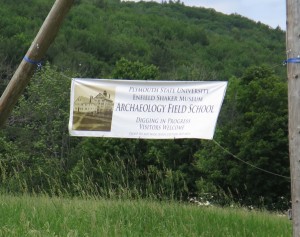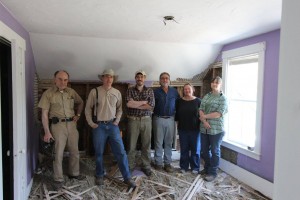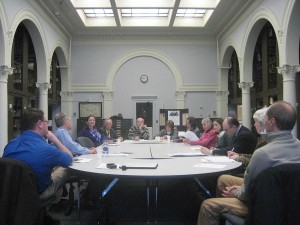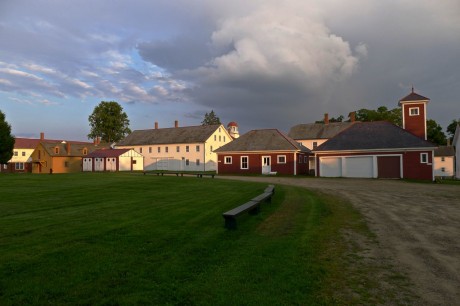Congratulations to Michael Desplaines, Erin Hunt, and Rick Kipphut, who will be awarded Master of Arts degrees in historic preservation at PSU’s commencement ceremony on May 14th.
Category Archives: Student Projects
Shaker Dig Update
The first professional excavation at the site of the Trustee’s Office and Store at Enfield Shaker Museum concluded on June 19th after a rainy second session. Museum staff reported that the corners of the building foundation had been located along with an assortment of artifacts and building materials.
The museum plans to renew the dig next summer and hopes to engage more of the Lake Mascoma community as volunteers in the effort. You can find news video and still photos at the WCAX website.
The Cadaver-House
Over the past week, a condemned house in Rochester, New Hampshire, served as the site of PSU instructor Jim Garvin’s class on building investigation (HPR 5320).
The property owner, Department of Transportation, Division of Historical Resources, and Plymouth State University collaborated in order to make this building available to students, who were permitted to use unusually invasive methods in order to discover precisely how the house was constructed.
Scheduled for demolition in the fall, the building has now been recorded through measured plans, elevations, and professional photographs. Its historical narrative has also been revised by deed, census, and map research conducted during the week — all suggesting that the house might be at least a decade older than previously thought. That earlier date was tested against the bricks and mortar, plaster and lathe, framing and sheathing, windows and doors, fasteners and hardware in the house and connected ell.

Two students, Rick Kipphut and Erin Hunt, contemplate the newly exposed wall sheathing in the ell at the study property in Rochester.
Each student is now responsible for drafting a different section of a Historic Structure Report, documenting and preserving evidence of this vernacular structure, unremarkable on the surface but surprisingly complex on closer inspection. Like a medical school cadaver, the house has taught one class of students some indelible lessons.
While we must wait for the final report to disclose specific details about the house, one thing seems clear: this project may be one the most innovative Section 106 mitigation measures yet devised, aiding future preservation projects in the state through the training of students in the field.
Enfield Shaker Dig
The Enfield Shaker Museum announced a summer field school, directed by Anthropology Prof. David Starbuck. The first-ever professional dig at the Enfield, New Hampshire, site will run from May 29 through June 19. Participants will learn basic field work techniques. Volunteers (age 18+) must make a two-week minimum commitment. PSU students can earn academic credit by attending the entire field school. Register early, as space is limited. Contact David Starbuck (dstarbuck@plymouth.edu) for more information and registration.
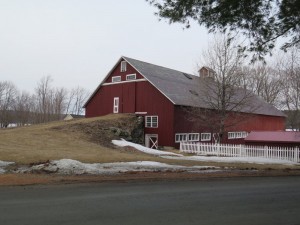 In addition to its ongoing preservation of the Great Stone Dwelling and West Brethren Shop, the museum recently acquired a special barn at the site. Built by the Shakers in 1854, this 4-level cow barn reflects the Shaker’s interest in agricultural productivity and labor-saving design. The barn is one of two multi-story Shaker barns remaining in the United States. See the museum’s Winter 2015 Newsletter for the full story.
In addition to its ongoing preservation of the Great Stone Dwelling and West Brethren Shop, the museum recently acquired a special barn at the site. Built by the Shakers in 1854, this 4-level cow barn reflects the Shaker’s interest in agricultural productivity and labor-saving design. The barn is one of two multi-story Shaker barns remaining in the United States. See the museum’s Winter 2015 Newsletter for the full story.
State Register Listings
This press release announced the New London listing:
On January 26, the State Historical Resources Council voted to list New London’s Whipple Memorial Town Hall in the State Register of Historic Places. The building’s significance was attributed to its Classical Revival architecture and its important role in the town’s development.
Boston hotelier Amos H. Whipple (1856–1916) bequeathed land and $15,000 for a public library building in his hometown of New London. The selectmen, however, asked his executor to alter the terms of the will, and so the proposed library became Whipple Memorial Town Hall, honoring Amos’s parents, Dr. Solomon and Henrietta Whipple. Dr. Whipple, of Croydon, had served the people of New London as their physician for his entire medical career, commencing in 1849 and ending shortly before his death in 1884.
The executor of Amos Whipple’s estate was his younger brother, Sherman L. Whipple (1862–1930). By 1916 Sherman was an eminent Boston trial lawyer. An alumnus and trustee of Colby Academy, he maintained lifelong ties to New London. He saw the new town hall as benefitting the townspeople and Colby Academy students, who would use Whipple Hall’s auditorium regularly over the next forty years. Sherman Whipple chose a Boston architectural firm, Strickland & Law, for the project; it was the firm’s first known public commission.
Sidney T. Strickland (1880–1954) graduated from MIT in 1905 and completed his architectural training at the École des Beaux-Arts in Paris. At MIT, Strickland had written and illustrated an undergraduate thesis on the design for a large city hall. He had learned the symbolic and functional requirements of civic spaces, and he adapted those principles to the rural town hall in New London. Strickland also studied Colby Academy’s nearby Colgate Hall, a Classical Revival design by George Harding of Pittsfield, Massachusetts. Colgate Hall was completed in 1912 by New London contractor Horace Stanley, who would also build Whipple Hall in 1917–18.
Whipple Memorial Town Hall included a jail cell, selectmen’s office, town records archive, kitchen, meeting/function room, auditorium and stage, and a moving picture projection booth. It had electric lights and two wood furnaces producing steam heat. Unanticipated later uses included the municipal and district courts, basketball court, civil defense and ham radio station, police station, produce and craft market, and recreation center. The original plan remains almost unchanged above the basement level. Two additions have been made at the rear (in 1985 and 1999), which today house the Police, Dispatch, and Recreation Departments. The town of New London is currently assessing the building’s need for historic preservation and other repairs.
Four other buildings in New London were previously listed in historic registers: the Dr. Solomon M. Whipple House (NR-1985), First Baptist Church (NR/SR-2005), New London Barn Playhouse (SR-2006), and Kentlands (SR-2008). Whipple Hall is the first municipal building in New London to be listed. Still in daily use, Whipple Hall’s centennial of service will be observed in June 2018.
Sustainable Preservation
Mae Williams enrolled in the Historic Preservation program in 2012. In a recent Plymouth Magazine article, she recounted her experience in one course, Sustainability and Preservation (HPR 5700, instructed by Mary Kate Ryan of the NH Division of Historical Resources). The course “focused on how we can use historic preservation as a tool not just for climate change mitigation but also as a way of creating economic growth.”
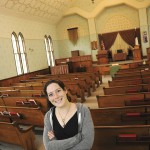
Read Mae’s article about preservation challenges and possibilities at the former Laconia State School…
Shaker Field Trips
We are fortunate to have the legacy of two Shaker communities located here in central New Hampshire. Now historical museums, the former villages provide great opportunities for the study of material culture, historic preservation, and industrial archaeology.
Back on April 26, Prof. David Starbuck took his Archaeological Methods (HPR 5600) class to Canterbury Shaker Village in order to examine the remains of a once extensive series of water-powered factories on the property. On May 14, the same class met at the Enfield Shaker Museum to learn about its ongoing preservation projects, especially those at the Great Stone Dwelling, stretching from basement to bell tower. Students had an opportunity to meet (and dine) with board members, staff, and volunteers responsible for all aspects of this impressive and painstaking work.
On July 31, Prof. Jim Garvin guided his Historic Methods & Materials (HPR 5310) students on an unusual tour of the Canterbury Shaker Village which focused on the variety of building materials and construction methods exhibited by the village’s 24 extant structures, dating from 1792 to 1923. Pressed brick, chiseled granite, crown glass, cut nails, white lead, roofing and siding of all kinds were among the topics explored.
PSU’s Historic Preservation program teaches students to see the layers of time imprinted on our landscape by architectural and decorative styles, by building materials and construction methods, by millponds and archaeological features. The Shaker villages bear the imprint of the the group’s creativity, ingenuity, and purposeful work. The villages also reflect the Shakers’ selective interaction with the wider world — leaving us with fascinating places to practice seeing time.

